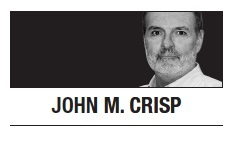 One would not think it would be necessary to remind ourselves occasionally of the awesome destructive potential of nuclear weapons. How could we forget?
One would not think it would be necessary to remind ourselves occasionally of the awesome destructive potential of nuclear weapons. How could we forget?
But citizens of a certain age remember when the possibility of sudden destruction and death, delivered via intercontinental ballistic missile, occupied a worrisome share of our national and individual psyches. Private citizens built bomb shelters, public schools developed courses on how to radiation-proof a home and municipalities designated the locations of public fallout shelters.
Hiroshima was the baseline for nuclear holocaust. On Aug. 6, 1945, a single B-29 flying at 31,000 feet dropped a single bomb, which exploded 580 meters above the city. Some 80,000 people were killed almost immediately by the blast and resulting firestorm. Many more died later from radiation poisoning. 13 square kilometers of the city were flattened.
The impressive destruction of Hiroshima — and of Nagasaki a few days later — occurred at the end of the most destructive war in history and in the context of other bombing raids that killed as many or more. The Tokyo firebombing of March 9, 1945, killed more than 100,000 people.
But Hiroshima changed everything. The tone was set for a generation, and what I’ll call the “duck and cover” era began. The message of this period was that nuclear destruction could rain down at any moment. Dozens of movies, TV shows and books dramatized the threat of nuclear holocaust and depicted the post-apocalyptic world. In November 1983, 100 million Americans watched “The Day After,” a depiction of a full-blown nuclear exchange between the US and the Soviet Union.
And then we sort of forgot about it. After the Soviet Union fell in the early ’90s, the nuclear tensions of several decades diminished and nuclear arsenals were reduced over time.
Nevertheless, nine countries still possess more than 15,000 nuclear warheads, each of which is many times more powerful than the modest 15 kilotons exploded over Hiroshima.
Should we be more worried about this than we appear to be? Yes. Beneath the deafening clamor of the world’s many current problems, the threat of nuclear annihilation hums so persistently in the background that we can easily forget that it’s there.
But world conditions are making the unthinkable not only possible or likely but maybe even inevitable. Two nuclear powers — China and Russia — are showing signs of increased aggression at a time when the US may be pulling back. Rogue and unstable nuclear states — North Korea and Pakistan — have indicated a willingness to use nuclear weapons. Non-state interests pose a nuclear threat, as well.
Climate change is already making resources scarcer in some areas, and increasing competition is sure to increase tensions. Institutions and power arrangements that tended to maintain stability — for good or ill — have broken down. Our culture has acclimated to considerable brutality, and we’re increasingly inclined to depersonalize other races and religions, just as we did the Japanese before Hiroshima.
Further, the US has elected a president with a casual attitude toward nuclear proliferation. He has said that the US should “greatly strengthen and expand its nuclear capability.” He has suggested that Japan and South Korea may need to develop their own weapons, and even Saudi Arabia, a development that — along with the abrogation of the nuclear deal — would give the Iranians a reason to develop nuclear weapons of their own.
If it turns into an arms race, Trump has said, “Let it be an arms race.” The US will “outmatch them at every pass and outlast them all.”
Unfortunately, in a nuclear exchange, there is no such thing as “outlasting” them.
The conditions are ripe for a devastating nuclear blast, or many of them. Trump did not create these conditions; in some respects the conditions created Donald Trump. And to an extent, his attitudes toward the nuclear threat, as well as climate change — two ominous backdrops to life on Planet Earth — reflect those of many of us: We know they’re out there, but it’s more comfortable not to think about them very much or to pretend that they don’t exist.
By John M. Crisp
John M. Crisp, an op-ed columnist for Tribune News Service, teaches in the English department at Del Mar College in Corpus Christi, Texas. – Ed.
(Tribune Content Agency)
- SC Bank Korea offers special rate for new customers
- AmCham seminar explores Korea’s potential as regional business hub
- [Kim Seong-kon] A great grandmother’s ‘Memoirs of the Times’
- [Editorial] Pension reform
- [Eric Posner] What to look for in Trump's first trial
- Med professors to resign this week amid prolonged doctors' walkout
- KITA partners with German VC fund to bolster auto firms in Gwangju
- Music festivals gear up for summer season
- Yoon’s jailed mother-in-law excluded from latest parole list
- Aging population to drive down Korea's housing prices from 2040: experts



![[AtoZ into Korean mind] Humor in Korea: Navigating the line between what's funny and not](http://res.heraldm.com/phpwas/restmb_idxmake.php?idx=644&simg=/content/image/2024/04/22/20240422050642_0.jpg&u=)
![[Exclusive] Korean military set to ban iPhones over 'security' concerns](http://res.heraldm.com/phpwas/restmb_idxmake.php?idx=644&simg=/content/image/2024/04/23/20240423050599_0.jpg&u=20240423183955)



![[Graphic News] 77% of young Koreans still financially dependent](http://res.heraldm.com/phpwas/restmb_idxmake.php?idx=644&simg=/content/image/2024/04/22/20240422050762_0.gif&u=)
![[Herald Interview] Why Toss invited hackers to penetrate its system](http://res.heraldm.com/phpwas/restmb_idxmake.php?idx=644&simg=/content/image/2024/04/22/20240422050569_0.jpg&u=20240422150649)





![[Exclusive] Korean military to ban iPhones over security issues](http://res.heraldm.com/phpwas/restmb_idxmake.php?idx=652&simg=/content/image/2024/04/23/20240423050599_0.jpg&u=20240423183955)



![[Today’s K-pop] Ateez confirms US tour details](http://res.heraldm.com/phpwas/restmb_idxmake.php?idx=642&simg=/content/image/2024/04/23/20240423050700_0.jpg&u=)